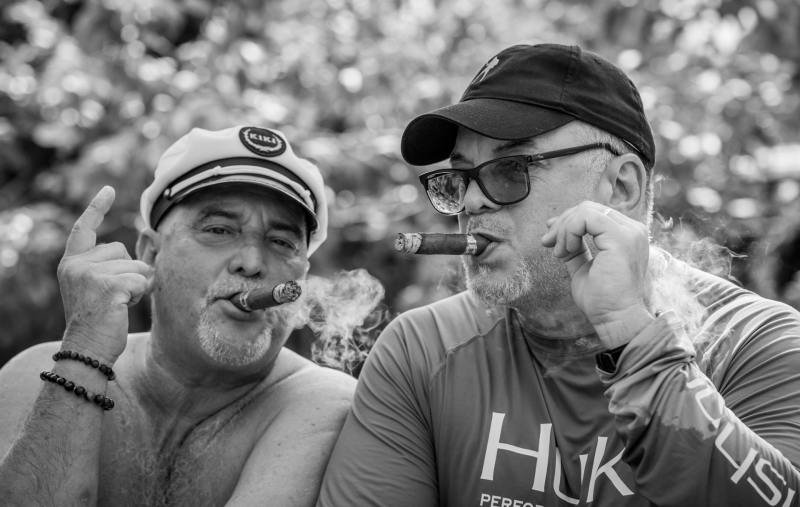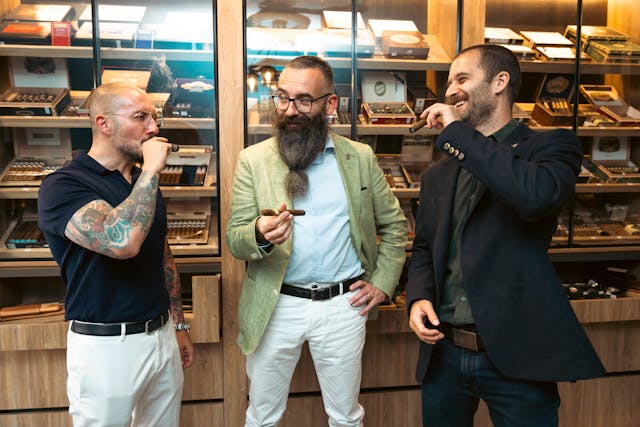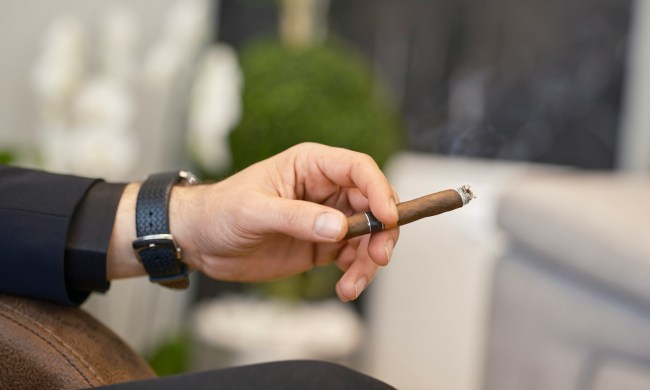You’re not the only one who has felt out of your league talking cigars with someone who obviously knows his stuff, trust me. To everyone else, the cigar world is a secret society with its own language—a mix of tradition, craftsmanship, and ritual that may as well be code to the onlooker. But here’s the secret–you don’t need years of puffing to sound like an aficionado.
This guide explains cigar jargon in the most approachable way possible. No BS, no elitism, no jargon— just straight talk in plain, everyday words. You’ll learn the basic structure of cigars, how to describe what you’re tasting, and how to talk shop without sounding like a rookie. Whether you’re sparking up at a lounge, perusing a humidor, or just kicking back, having the lingo effortlessly rolling off your tongue will elevate your cigar game instantly.
Let’s get you sounding like you’ve been at this for years.
Why cigar terminology matters

It’s like going into a wine bar and ordering ‘the red stuff’. Not ideal, right? The same goes for cigars. Knowing the right language helps you:
- Pick a cigar that suits your preferences: You can accurately describe what you like (mild, spicy, sweet, full-bodied) and understand what retailers or other cigar smokers recommend to you.
- Understand the craftsmanship: Once you know what goes into the construction of a cigar—from the wrapper to the filler—you appreciate it more.
- Join the conversation: Whether online or in a cigar lounge, knowing how to talk cigars helps you engage in discussions, ask informed questions, and get better recommendations.
Plus, it pays homage to an age-old art and keeps you from spending money on cigars you don’t like anyway.
The culture of cigar lovers

Cigars are intensely social. Unlike cigarettes, which you tend to quickly indulge in isolation, cigars beckon you to relax, linger, and enjoy. Understanding cigar speak leads to:
- Lounge camaraderie: Most cigar lounges aren’t just retail shops—they’re community hubs. They bring people together to light up and connect over a passion for cigars. Knowing the language allows you to fit in and participate actively.
- Shared rituals: From cutting and toasting to discussing flavor notes, cigar culture includes rituals many smokers take seriously.
- Events and herfs: A “herf” is a casual cigar gathering where people swap stories, cigars, and knowledge. Speaking the lingo makes you feel like part of the tribe.
The anatomy of a cigar

Cigars have three main parts. They all influence how the cigar tastes, burns, and rests in your hand.
The wrapper is the outermost leaf. It provides the cigar with the bulk of its flavor and appearance. Wrappers are chosen not just for their look, but also for how they pair with the filler blend. They can vary from light tan (Connecticut Shade) to almost black (Maduro).
Shade-grown wrappers (like Connecticut) are grown under cloth to produce smoother, thinner leaves. Sun-grown wrappers (like Habano) are exposed to full sunlight, often resulting in thicker, more flavorful leaves.
The binder is a leaf that sits right beneath the wrapper. Its job is to bind the filler tobacco and help the cigar maintain its shape. And even though it typically doesn’t add much flavor, it is also essential in the burning of the cigar.
The filler is the heart and soul of the cigar. It’s a mix of all long tobacco leaves, and the mix of types, regions, and aging it determines the cigar’s strength, complexity, and burn rate. Fillers can be single country or blended from multiple (a “multi-country blend”).
Size and shape 101
The size and shape of a cigar are called the vitola. Both can affect the taste and the overall smoking experience.
Ring gauge is the thickness of the cigar, measured in 64th-of-an-inch increments. A 50-ring gauge indicates that the cigar is 50/64 inches thick. Thicker cigars (60+ ring gauge) tend to burn cooler and grant more space for an intricate filler blend.
Length is simply how long the cigar is, measured in inches. Shorter cigars burn faster. Longer cigars also provide more burn time for flavors to explode and develop. If you’re pressed for time, opt for something like a Robusto. Looking to relax for an hour or so? A Churchill suits better.
Common vitolas
- Robusto: 5 inches by 50 ring gauge. A great all-rounder.
- Corona: Around 6×42. A bit more cultivated, softer to the touch.
- Toro: 6×50 or 6×52. A popular modern size.
- Figurado: Any cigar that isn’t a straight cylinder. Think torpedoes or bellicosos. They’re more difficult to roll and usually more expensive, but worth it for their unique flavor delivery.
Types of packaging
Cigars are presented to consumers in different forms:
Box-pressed: Cigars that are pressed into square shapes while being boxed. Some claim they smoke cooler or burn longer.
Bundle: A low-cost way to buy cigars. They’re sold with no frills boxes, wrapped in cellophane, and typically sold in bulk.
Cabinet: A large wooden box used for aging or storing cigars, especially at factories or shops.
Basic cigar terminology

Draw: Indicates how freely air moves through the cigar when you puff. A nice draw translates into even, unbroken airflow. A cigar with a tight draw is like sucking on a clogged straw.
Burn: It’s all about how the cigar gets consumed by fire. A good cigar burns on an equal line all around. If one side burns faster, it’s called canoeing. If the cigar tunnels, it’s burning inside unevenly.
Ash: What’s left of a cigar after a burn. A long, hard ash is an indication of a well-built cigar. Gray or white ash is the most common. If it flakes and falls apart immediately, the tobacco could be too dry or badly rolled.
Strength: That’s the nicotine’s potency. A mild-strength cigar will not buzz you. A full-strength cigar can knock your socks off if you’re not prepared.
Body: This refers to how heavy or intense the smoke feels in your mouth. Full-bodied cigars taste thick and rich. Light-bodied ones seem ethereal and soft.
Flavor: This is the taste profile. Consider chocolate, leather, wood, spice or coffee. It has nothing to do with how powerful the cigar is.
Hand-Rolled: These are made by skilled workers and often use long-leaf tobacco. They’re more expensive, but they taste and burn way better.
Machine-Made: Mass-produced in a factory, often with short filler (chopped tobacco). Inexpensive and efficient, but you sacrifice complexity and artistry.
Retrohale: Exhaling softly though your nose to capture nuances. The nose is more delicate than the tongue, so you can frequently smell additional notes.
Finish: This is the flavor that remains in your mouth after the puff. A fine cigar is never short on the finish. Bad ones wear off quickly or taste sour or unpleasant.
Complexity: A complex cigar has shifting flavors as you smoke. Maybe it’s sweet up front then spicy, and then earthy as you go along. It keeps your palate interested.
Buying and storing cigars
Humidor: A box that stores cigars at proper humidity (70-ish%) and temperature (70-ish degrees Fahrenheit). This maintains cigars fresh, flavorful, and burn-ready.
Hygrometer: Measures your humidor’s internal humidity. Analog ones are cool, but digital ones are generally more accurate.
Seasoning: Hydrating the humidor wood using Boveda packs or water before use. This prevents the humidor from leaching moisture from your cigars and drying them out.
Smoking etiquette

Cutting: Using a proper cutter, V-cutter, or punch to snip off the head (the closed end) to allow airflow. Be sure to snip off just enough, or the wrapper will unravel.
Toasting: Lightly warming the foot (the open end you light) before puffing. This helps your cigar light evenly and avoid harsh flavors.
Lighting: Setting the end of the cigar on fire. The best way to do this is to use a butane lighter or wooden matches with slow, circular motions. Avoid Zippos or lighter fluid of any kind—they taint the flavor.
Lounge lingo
Herf: A casual, fun, social cigar-smoking get-together.
Tight draw: When it’s hard to puff.
Burn even: When the cigar is burning perfectly along the edges.
Nubbing: Smoking the cigar to its very end.
Dog rocket: A really bad cigar.
Good-to-knows

Plume is a white, powdery bloom made from natural oils. It’s completely natural and a good sign of aging.
Mold is green, blue, or fuzzy and bad. Toss the cigar.
Aging: Letting cigars rest for weeks or months in a humidor, while monitoring them, to allow the tobacco to mellow and the flavors to intensify.
Cuban vs. Non-Cuban: Cubans are cigars from Cuba. They are classic yet expensive, rare, and difficult to get in certain countries. Non-Cuban cigars from Nicaragua, Honduras, and the Dominican Republic have earned serious respect, often matching Cubans in flavor and quality.
A quick recap:
Aging: Resting cigars to boost flavor
Binder: Leaf that secures the filler
Draw: How easy it is to pull smoke
Figurado: A weirdly-shaped cigar (non-cylindrical)
Foot: The end you light
Humidor: Keeps cigars humid and fresh
Plume: White crystals from aging
Ring Gauge: How thick the cigar is
Wrapper: The outer leaf that defines the look and taste
Why it all matters

Mastering cigar terms smartens you up into an articulate smoker. You’ll pick authentic, superior cigars that you actually like, appreciate them more, and tap into a vibrant culture that celebrates craftsmanship and wind-downs.
Talk the talk, and every toke is more than just smoke – it’s a tale, a bond, an adventure worth relishing.




